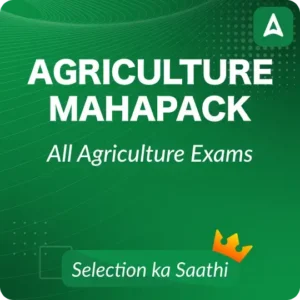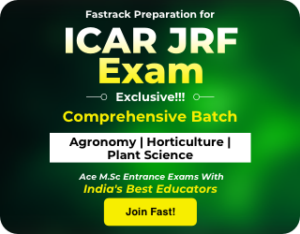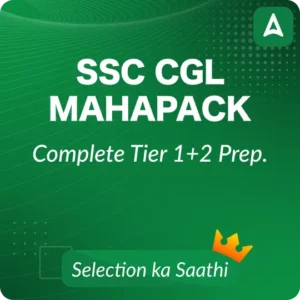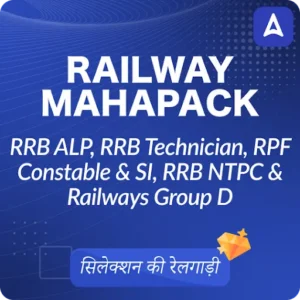The Andhra Pradesh Public Service Commission has officially released the APPSC Agriculture Officer exam dates on its website. According to the notification, the exam will be held over two consecutive days on 27 and 28 January 2026. With the dates now confirmed, candidates must put their preparation in top gear and revise strategically. Check out the subject-wise APPSC Agriculture Officer Syllabus 2025 and detailed exam pattern in the article below to plan effectively.
APPSC Agriculture Officer Syllabus 2025
The APPSC Agriculture Officer Exam Date has been officially announced, so candidates should now begin the final phase of their preparation. The selection process for APPSC Agriculture Officer Recruitment comprises two stages: a Written Exam followed by a Computer Proficiency Test (CPT). To create an effective study plan, candidates must review the detailed, subject-wise syllabus for both stages provided in the article below.
APPSC AO Syllabus 2025: Subject-wise
The APPSC AO Syllabus 2025 covers essential topics from General Studies & Mental Ability and core Agriculture subjects to assess both analytical skills and domain knowledge. Below is the detailed subject-wise syllabus for your reference.
APPSC AO Syllabus: General Studies and Mental Ability (Paper-II)
- Major Current Events and Issues about International, National and the State of Andhra Pradesh.
- General Science and its applications to the day-to-day life, Contemporary developments in Science & Technology and Information Technology.
- History of India – emphasis will be on a broad general understanding of the subject in its social, economic, cultural and political aspects, with a focus on AP and the Indian National Movement.
- Geography of India with a focus on Andhra Pradesh.
- Indian Polity and Governance: constitutional issues, public policy, reforms and eGovernance initiatives.
- Indian Economy and Planning
- Sustainable Development and Environmental Protection
- Disaster management: vulnerability profile, prevention and mitigation strategies, Application of Remote Sensing and GIS in the assessment of disasters
- Logical reasoning, analytical ability and logical interpretation.
- Data Analysis: Tabulation of data, Visual representation of data, Basic data analysis (Summary Statistics such as mean, median, mode and variance)and Interpretation.
APPSC Agriculture Officer Syllabus: Agriculture (Paper-I)
| Syllabus Unit | Key Topics Covered |
| Introductory Agriculture & Agronomy |
Elements of crop production; factors affecting production; history & technological timeline; Indian agriculture balance sheet; physiographic diversity; soil/weather/economic constraints; farming systems; value addition; women in agriculture (roles, empowerment, drudgery-reducing tech); group dynamics; extension & training; scope of agronomy; national & international agri research institutes; agro-climatic zones; tillage, planting geometry, crop stand, cropping systems, harvesting.
|
| Field Crops – Kharif |
Origin, distribution, importance, soil & climate, varieties, cultural practices, yield of: Cereals (rice, maize, sorghum, pearl millet, minor millets); Pulses (pigeonpea, mungbean, urdbean); Oilseeds (groundnut, sesame, soybean); Fibres (cotton, jute, sunhemp); Forage (sorghum, maize, cowpea, cluster bean, napier).
|
| Field Crops – Rabi |
Origin, distribution, importance, soil & climate, varieties, practices & yield of: Cereals (wheat, barley); Pulses (chickpea, lentil, peas, french bean); Oilseeds (rapeseed–mustard, sunflower, safflower, linseed); Sugar crops (sugarcane, sugar beet); Medicinal/Aromatic (citronella, palma rosa, isabgol); Commercial (potato, tobacco); Forage (lucerne, oat).
|
| Weed Management |
Weeds: effects, classification, propagation; biology & ecology; crop-weed competition, allelopathy; weed prevention, control, eradication; physical, cultural, chemical, biological methods; IWM; herbicides (classification, formulations, application); adjuvants; selectivity; compatibility; weed control in major crops; shift in weed flora; aquatic & problematic weeds; herbicide-resistant crops.
|
| Water Management & Micro-Irrigation |
Water resources & irrigation development; soil–plant–water relations; soil moisture estimation; ET & crop water requirement; effective rainfall; irrigation scheduling; irrigation methods (surface, sprinkler, drip); irrigation efficiency, WUE; conjunctive use; water quality; crop-wise water management (rice, wheat, maize, groundnut, sugarcane, mango, banana, tomato); drainage.
|
| Organic Farming |
Concept & relevance; organic standards; INM (manures, vermicomposting, green manuring, residues, biofertilizers); soil improvement; organic pest & disease management (biocontrol, pheromones, trap crops); weed management; quality & certification; labeling; accreditation; marketing; exports.
|
| Farming Systems & Sustainable Agriculture |
Sustainable agriculture: definition, goals, ecological balance factors; land degradation; natural resource conservation; LEIA vs HEIA; irrigation problems; wasteland development; principles of organic farming; farming systems definition & components; IFS models for wetland, irrigated dryland & dryland.
|
| Principles of Plant Breeding |
Objectives; modes of reproduction (sexual/asexual/apomixis); pollination types; breeding methods: introduction, acclimatization, mass selection, pure line, hybridization types, pedigree/bulk/back-cross methods; incompatibility, male sterility; heterosis & inbreeding depression; recurrent selection; synthetics & composites; clonal & mutation breeding; ploidy & wide hybridization; PGR conservation; ideotype concept; resistance breeding; pathogen variability; mechanisms of resistance; adaptability; biometrics (additive, dominance, epistasis); G×E interaction; IPR basics.
|
| Principles of Seed Technology |
Seed production basics; seed policy; demand forecasting; deterioration & control; genetic purity maintenance; seed quality parameters; seed classes; nucleus/breeder/foundation/certified seed production; maintenance of new varieties; certification process, phases, inspections; Seed Act & enforcement.
|
| Principles of Plant Biotechnology |
Tissue culture history & scope; totipotency; in-vitro culture techniques (micropropagation, anther, ovule, embryo, endosperm culture); somaclonal variation; somatic embryogenesis; synthetic seeds; protoplast isolation & fusion; somatic hybrids & cybrids; genetic engineering: restriction enzymes, vectors, gene transfer (direct/indirect), transgenic plants; blotting; DNA fingerprinting; markers (RFLP, AFLP, RAPD, SSR); QTL mapping; MAS applications; future prospects.
|
| Soil Science & Agricultural Chemistry |
Soil formation, rocks & minerals, weathering; soil profile; physical properties (texture, structure, BD, PD, porosity, compaction); soil water (retention, infiltration, constants); soil temperature & aeration; soil colloids; clay minerals; ion exchange (CEC/AEC); soil organic matter, humus, C:N; soil biology; soil classification; soils of India.
|
| Soil Fertility & Nutrient Management |
Essential nutrients & forms; nutrient transport; factors affecting availability; deficiency/toxicity correction; problem soils (acidic, saline, sodic, calcareous) & reclamation; fertilizers & pesticides effects on soil/water; water quality standards; saline water use; soil fertility evaluation (chemical, plant analysis, DRIS, biological methods); critical levels; rapid tissue tests; nutrient use efficiency (N, P, K, S, Fe, Zn); soil-test based recommendations.
|
| Entomology (Morphology & Systematics) |
History; arthropod classification; insect morphology (cuticle, moulting, segmentation, head/thorax/abdomen structures); antennae, mouthparts, legs, wings; sensory organs; metamorphosis & diapause; larval/pupal types; digestive, circulatory, respiratory, excretory, nervous, endocrine, reproductive systems; reproduction types; taxonomy principles; insect classification up to orders; major pest families.
|
| Insect Ecology & IPM |
Ecology basics; abiotic & biotic factors; pest outbreak causes; pest surveillance & forecasting; pest categories; IPM concepts & tools: host plant resistance, cultural/mechanical/legislative/biological control; chemical control & hazards; insecticide classification, toxicity, formulations; botanicals; new-generation insecticides; nematicides, rodenticides, acaricides, fumigants; repellents, hormones, attractants, radiation & genetic control; Insecticides Act 1968; application techniques; poisoning symptoms & antidotes; beneficial insects & mass rearing; microbial pesticides; pollinators, weed killers, scavengers.
|
| Pests of Field Crops & Stored Grains |
Stored grain pests (Coleopteran, Lepidopteran) biology & control; major crop pests: rice, sorghum, maize, ragi, wheat, sugarcane, cotton, sunhemp, pulses, groundnut, castor, sesame, safflower, sunflower, mustard, cumin, fennel, spinach, amaranthus, tobacco; mites, rodents, birds.
|
| Agricultural Economics |
Definitions & divisions; goods, utility, value, wealth; wants & classifications; consumption theory; law of diminishing marginal utility; consumer surplus; demand concepts & law; elasticity types & measurements; welfare economics basics; national income concepts; taxes & canons; inflation types.
|
| Agricultural Marketing, Trade & Prices |
Marketing concepts; market structure–conduct–performance; market functionaries; producer surplus & marketable/marketed surplus; marketing channels; market integration; marketing costs, margins, price spread; international trade concepts (GATT, WTO); cooperative marketing; warehousing (CWC, SWC); FCI roles; AGMARK; agricultural price policy; marketing risks, speculations, hedging, futures; contract farming; e-NAM.
|
APPSC Agriculture Officer Syllabus: Computer Proficiency Test (CPT)
Part A – Computer Fundamentals
| Unit | Topics Covered |
| Introduction to Computers |
Basics, components, classification; peripheral devices; input devices (keyboard, mouse, scanner, touchscreen, joystick, microphone, digital camera, barcode reader, biometric sensor); output devices (monitor, printer, speaker, plotter); secondary storage (FDD, magnetic tape, USB, pen drive, disks); data & information; RAM, ROM, CU, MU, ALU.
|
| Computer Software Types |
System software, application software, embedded software, proprietary & open-source software (purpose & characteristics).
|
| Operating System Concepts | Functions of OS: single-user & multi-user OS with examples. |
| Windows Operating System |
GUI introduction; CUI vs GUI; file/folder operations; running applications via file manager/program manager; setting up printers, webcams, scanners & other peripherals.
|
| Linux / MAC OS (Basics) |
Features, advantages, file & directory commands; user management; file permissions; basics of MAC OS, its advantages & basic commands.
|
| Internet Concepts |
Hardware/software requirements; communication protocols; browsers; IP address; connecting to the network; uploading & downloading files.
|
| Electronic Mail |
Sending/receiving emails; email functions; using a word processor for email; mailing lists & list servers.
|
| World Wide Web | Advantages of WWW: navigating websites; web searching. |
Part B – Office Suite
| Unit | Topics Covered |
| Office Suite Basics |
MS Office / LibreOffice / OpenOffice / NeoOffice; starting & exiting applications; office shortcut bar; customisation.
|
| File Operations |
Opening apps; creating files; entering/editing text; saving, opening, closing files; file management; exiting applications.
|
| Common Tools & Techniques |
Cut/copy/paste; drag-drop; undo/redo; spell check; autocorrect; find/replace; help; templates & wizards.
|
| Word Processing (MS Word/Libre/OpenOffice/Neo) |
Interface; creating/opening documents; formatting; copying/moving text; page setup; printing; views (normal, web, print, outline); headers/footers; page numbers; auto text; objects; graphics; tables; sorting; styles; language; word count; hyperlinks; bookmarks; mail merge; macros; custom toolbars; shortcuts.
|
| Spreadsheet (MS Excel/Libre/OpenOffice/Neo) |
Worksheet basics; navigating; editing formulas; autofill; custom lists; protecting sheets; formatting; row/column management; sorting data; inserting/deleting cells; page setup; borders; hiding rows/columns; formulas; functions; charts; chart wizard; resizing; trendlines; graphics; macros; subtotals; CSV format; database usage.
|
| Presentation Software (PowerPoint/Libre/OpenOffice/Neo) |
Introduction; views; slides; formatting; templates; auto content wizard; text editing; images, clipart & graphics; drawing; animations; multimedia; transitions; slide show setup; printing; finalising presentation.
|
APPSC Agriculture Officer Exam Pattern 2025
The APPSC Agriculture Officer Exam Pattern 2025 consists of two phases: the written exam and the Computer Proficiency Test (CPT). The exam formats of both have been discussed below:
Written Exam
The written exam will be objective type and will consist of two papers; General Studies & Mental Ability and Agriculture. Each paper has 150 questions for 150 marks, and a duration of 150 minutes. For every wrong answer, 1/3rd mark will be deducted.
| APPSC AO Exam Pattern 2025 |
||||
| Paper | Subjects | No. of Questions | Exam Duration | Maximum marks |
| Paper-I | General Studies & Mental Ability | 150 | 150 mins | 150 |
| Paper-II | Agriculture | 150 | 150 mins | 300 |
| Total | 450 | |||
Computer Proficiency Test (CPT)
The Computer Proficiency Test (CPT) is a practical-type examination assessing candidates’ skills in office automation and computer usage.
| APPSC AO Exam Pattern 2025 |
|||
| Test | Duration | Maximum Marks | Minimum Qualifying Marks |
| Proficiency in Office Automation with the use of Computers and Associated Software | 60 mins | 100 |
|




 UP Lekhpal Syllabus and Exam Pattern 202...
UP Lekhpal Syllabus and Exam Pattern 202...
 TNPSC Group 3 Syllabus 2026 and Exam Pat...
TNPSC Group 3 Syllabus 2026 and Exam Pat...
 Punjab Police Constable Syllabus 2026 an...
Punjab Police Constable Syllabus 2026 an...




 Adda247 Job portal has complete information about all Sarkari Jobs and Naukri Alerts, its latest recruitment notifications, from all state and national level jobs and their updates.
Adda247 Job portal has complete information about all Sarkari Jobs and Naukri Alerts, its latest recruitment notifications, from all state and national level jobs and their updates.



